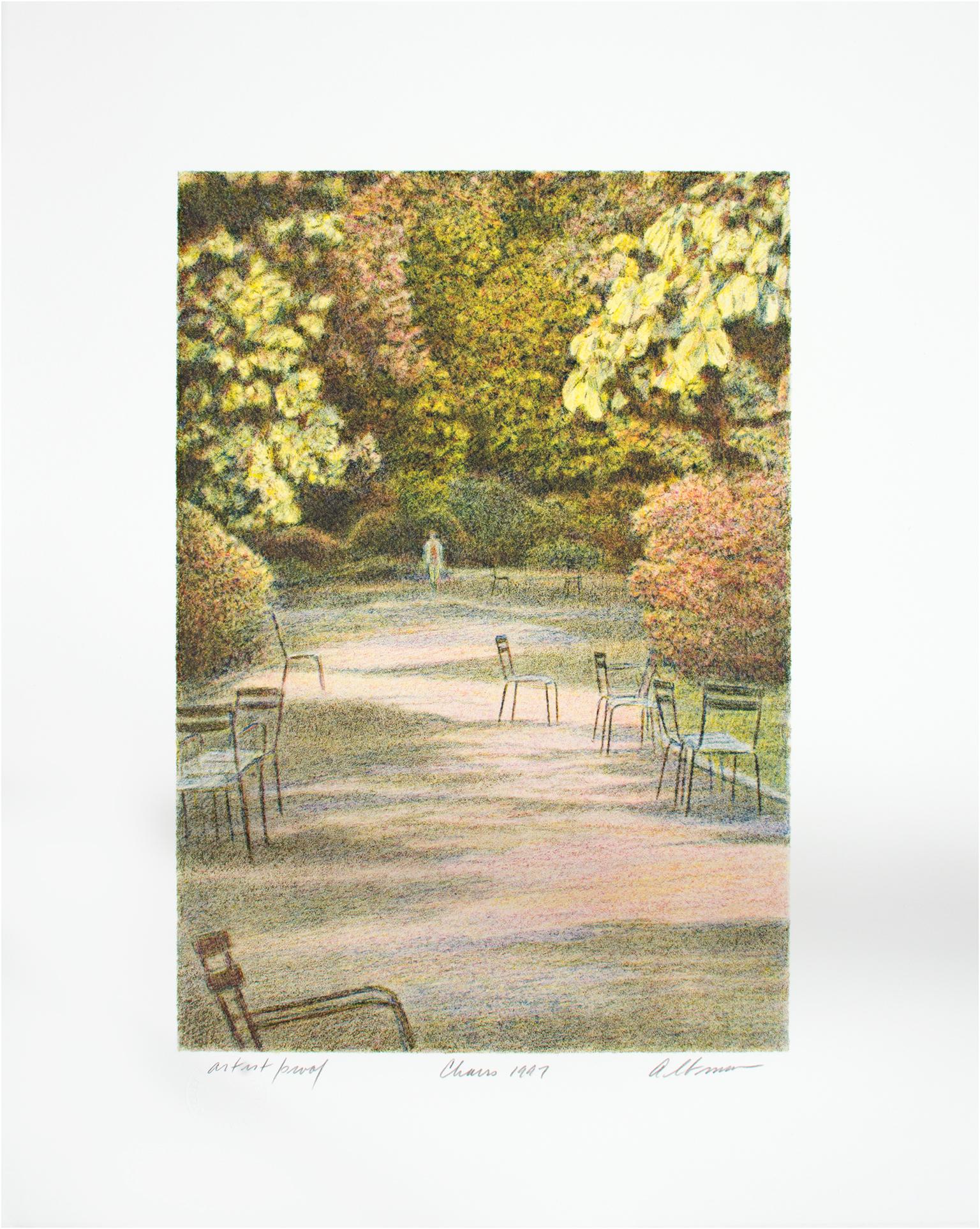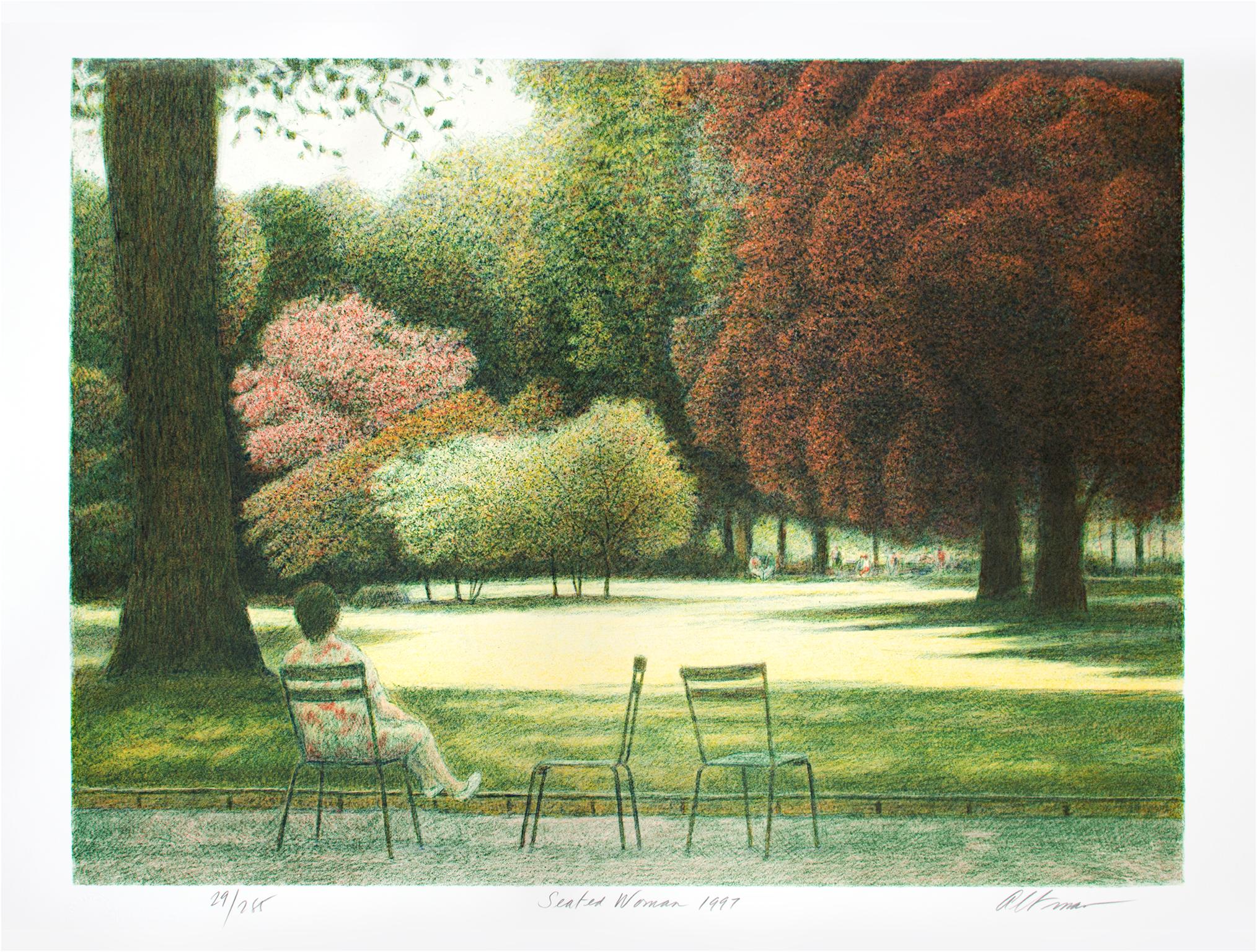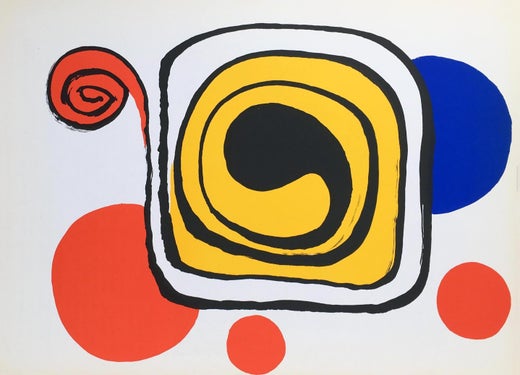Alexander Calder"Maeght Editeur, " Original Color Lithograph Poster signed by Alexander Calder1971-2
1971-2
About the Item
- Creator:Alexander Calder (1898 - 1976, American)
- Creation Year:1971-2
- Dimensions:Height: 31 in (78.74 cm)Width: 19 in (48.26 cm)
- Medium:
- Movement & Style:
- Period:
- Condition:
- Gallery Location:Milwaukee, WI
- Reference Number:
Alexander Calder
The American sculptor Alexander Calder is known as the father of the mobile, a moving artwork composed of delicately balanced sculptural forms suspended from the ceiling.
Because Calder's parents, both artists themselves, did not want him to suffer the hardships of trying to make a living in art, they encouraged the young Calder to study mechanical engineering at the Stevens Institute of Technology, in Hoboken, New Jersey. He worked a number of jobs, including as a hydraulic engineer and draftsman for the New York Edison Company, before deciding to pursue an artistic career. He never abandoned his engineering background, however, applying his understanding of gears and moving parts in all his artworks, from mechanical toys like the Cirque Calder (1931) and his revered prints to his free-standing abstract sculptures, called stabiles.
In 1926, Calder moved to Paris and established a studio in the Montparnasse quarter. He began creating the many parts of his famous miniature circus from found materials, such as wire, string, cloth, rubber and cork. Designed to be transportable, Cirque grew to fill five suitcases over the years. Always interested in putting forms in motion, Calder also pioneered a new art form called wire sculptures, which he described as “drawings in space.” Like his famous mobiles, the wire sculptures were suspended so that they turned with any movement of the air, presenting different forms when viewed from different angles.
In the 1950s, Calder returned to his roots in mechanical engineering, creating monumental abstract sculptures that verged on the architectural. He worked from loose gestural drawings like this preparatory sketch for his Man Stabile, from 1966. Throughout his career, he also worked as a set designer for the theater, as well as an illustrator and printmaker, producing vibrant, whimsical drawings for books and journals.
Find original Alexander Calder art today on 1stDibs.
- ShippingRetrieving quote...Ships From: Milwaukee, WI
- Return PolicyA return for this item may be initiated within 14 days of delivery.
- Late 20th century color lithograph landscape tree winter snow house signedBy Helen RundellLocated in Milwaukee, WI"North Fork" is an original color lithograph by Helen Rundell, signed in the lower right corner and numbered in the lower left. The piece features a brick c...Category
1980s Post-Modern Landscape Prints
MaterialsLithograph
- Contemporary color lithograph landscape trees outdoor forest park scene signedBy Harold AltmanLocated in Milwaukee, WI"Chairs" is an original color lithograph by Harold Altman. It is an artists proof signed in the lower right hand corner. The print is of a park landscape with various chairs spread a...Category
21st Century and Contemporary Post-Modern Landscape Prints
MaterialsLithograph
- Contemporary color lithograph landscape trees outdoor forest park scene signedBy Harold AltmanLocated in Milwaukee, WI"Parc Monceau" is an original color lithograph by Harod Altman. It is a signed edition 29/285. It features a park scene, and is a great example of Altman'...Category
21st Century and Contemporary Post-Modern Landscape Prints
MaterialsLithograph
- Contemporary color lithograph landscape trees outdoor forest park scene signedBy Harold AltmanLocated in Milwaukee, WI"Seated Woman" is an original color lithograph by Harold Altman. It is number 29 out of an edition of 285, signed by the artist in the lower right hand corner. A seated woman look ov...Category
21st Century and Contemporary Post-Modern Landscape Prints
MaterialsLithograph
- Contemporary color lithograph landscape trees outdoor forest park scene signedBy Harold AltmanLocated in Milwaukee, WILeave it to artist Harold Altman to capture the beauty of nature as we delight in a "Quiet Afternoon". This work is an original color lithograph, number 28 out of an edition of 285, ...Category
21st Century and Contemporary Post-Modern Landscape Prints
MaterialsLithograph
- Contemporary color lithograph landscape trees outdoor forest park scene signedBy Harold AltmanLocated in Milwaukee, WI"Allee" is an original color lithograph by Harold Altman. It is 21 out of an edition of 285, signed by the artist in the lower right hand corner. This print features a bustling parkw...Category
21st Century and Contemporary Post-Modern Landscape Prints
MaterialsLithograph
- Architectural StudyBy Ettore SottsassLocated in Greding, DELarge format lithograph with architectural study, partly coloured. Signed at lower right. Edition 65/100(?).Category
Late 20th Century Post-Modern Landscape Prints
MaterialsLithograph
- “Holland”Located in Southampton, NYOriginal offset colored lithograph travel poster titled “Holland” by the Dutch artist, Paul Erkelens. Signed in the print lower right and dated 1945. Published by Dejong & Company,...Category
1940s Post-Modern Landscape Prints
MaterialsLithograph
- Italian Post Modern Pop Art Lithograph Silkscreen Valerio Adami Galerie MaeghtBy Valerio AdamiLocated in Surfside, FLTitled Ledoux, color limited edition lithograph. Hand signed by artist in pencil to right hand corner, 101/150 to left. 19.5" X 14" print view area. This is done in a Postmodernist, Memphis Milano style. Valerio Adami (born 17 March 1935) is an Italian painter. Educated at the Accademia di Brera in Milan, he has since worked in both London and Paris. His art is influenced by Pop Art. Adami was born in Bologna. In 1945, at the age of ten, he began to study painting under the instruction of Felice Carena. He was accepted into the Brera Academy (Accademia di Brera) in 1951, and there studied as a draughtsman until 1954 in the studio of Achille Funi. In 1955 he went to Paris, where he met and was influenced by Roberto Matta and Wifredo Lam. His first solo exhibition came in 1959 in Milan. In his early career, Adami's works were expressionistic, but by the time of his second exhibition in 1964 at Kassel, he had developed a style of painting reminiscent of French cloisonnism, featuring regions of flat color bordered by black lines. Unlike Gauguin, however, Adami's subjects were highly stylized and often presented in fragments. In the 1970s, Adami began to address politics in his art, and incorporated subject matter such as modern European history, literature, philosophy, and mythology. In 1971, he and his brother Giancarlo created the film Vacances dans le désert. In 1974 he illustrated a Helmut Heissenbuttel poem, Occasional Poem No. 27. Ten Lessons on the Reich with ten original lithographs {Galerie Maeght}. In 1975, the philosopher Jacques Derrida devoted a long essay, "+R: Into the Bargain", to Adami's work, using an exhibition of Adami's drawings as a pretext to discuss the function of "the letter and the proper name in painting", with reference to "narration, technical reproduction, ideology, the phoneme, the biographeme, and politics". The Galerie Maeght is a gallery of modern art in Paris, France, and Barcelona, Catalonia, Spain. The gallery was founded in 1936 in Cannes. The Paris gallery was started in 1946 by Aimé Maeght. The artists exhibited are mainly from France and Spain. Since 1945, the gallery has presented the greatest modern artists such as Matisse, Bonnard, Braque, Miró, and Calder. In 1956, Adrien Maeght opened a new parisian venue. The second generation of “Maeght” artists was born: Bazaine, Andre Derain, Giacometti, Kelly, Raoul Ubac, then Riopelle, Antoni Tapies, Pol Bury and Adami, among others. There were four retrospective exhibits of Adami's work between 1985 and 1998. They were held in Paris, the Centre Julio-Gonzalez de Valence (Spain), Tel Aviv, and Buenos Aires. In 2010, the Boca Raton Museum of Art devoted a special exhibit to Adami's Post Modern paintings and drawings. Derriere le Miroir, the editor was Aimé Maeght. Derrière le Miroir is a French art magazine created in 1946 and published until 1982...Category
1980s Post-Modern Landscape Prints
MaterialsLithograph
- StarsLocated in Ljubljana, SIStars. Original color lithograph, 1975. Edition of 16 signed and numberes impressions on Arches paper. Metka Krašovec is one of the most important painters in contemporary Slovenian ...Category
1970s Post-Modern Abstract Prints
MaterialsLithograph
- Two flowersBy Ivan RabuzinLocated in Ljubljana, SITwo flowers. Original lithograph in colors, unknown year. Edition of E.A. (artist’s proof) signed and numbered impressions on Arches paper. Ivan Rabuzin wa...Category
Late 20th Century Post-Modern Landscape Prints
MaterialsLithograph
- RoosterBy Ivan RabuzinLocated in Ljubljana, SIRooster. Original lithograph in colors, 1963. Edition of 40 signed and numbered impressions on Arches paper. Ivan Rabuzin was a Croatian naive painter a...Category
1960s Post-Modern Animal Prints
MaterialsLithograph
Recently Viewed
View AllRead More
Renowned for His Mobiles, Alexander Calder Was Also Adept at Crafting Modernist Jewelry
There are no sparkling gemstones on this necklace, but its value far exceeds the cost of its materials.
10 Must-Visit American Public Sculptures
Get your dose of Vitamin D while surveying works by the likes of Alexander Calder, Keith Haring and Pablo Picasso.






